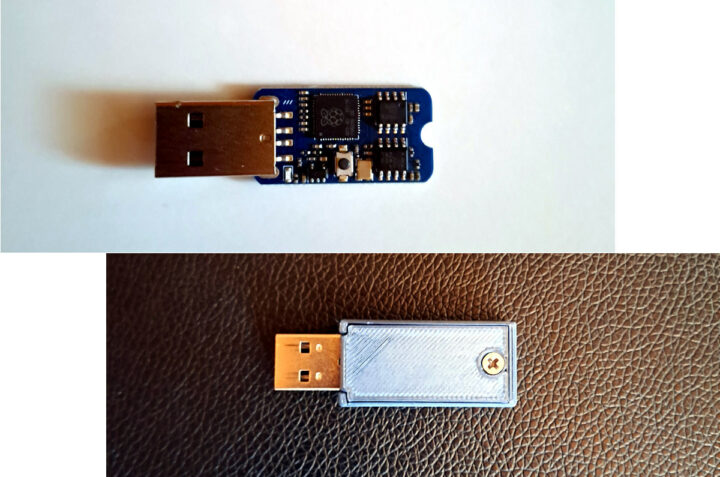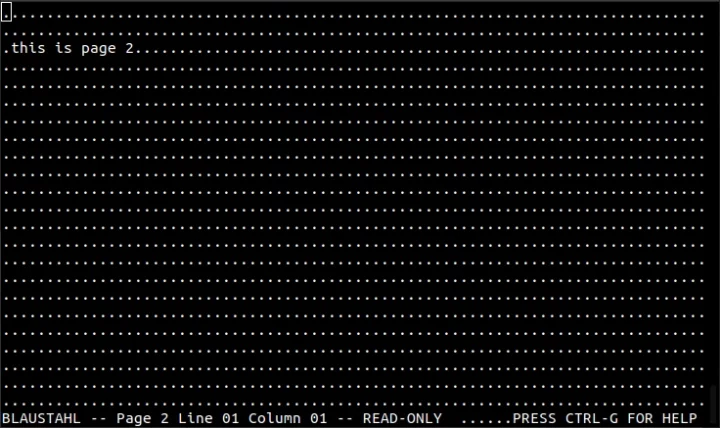Machdyne’s Blaustahl is a USB storage device equipped with a Raspberry Pi RP2040 MCU and 8KB of FRAM with a potential lifespan of over 200 years and designed for long-term storage of text up to about 8,000 characters.
FRAM (Ferroelectric RAM) has been around for years delivering ultra-low power consumption, faster writes, and ultra-long write endurance (one million billion read/write cycles) compared to EEPROM or NOR flash, but the cost is quite higher and it’s mostly used in applications that require ultra-low power consumption and non-volatile storage write capabilities such as data logging, sensor networks, batteryless applications. The Blaustahl storage device and USB text editor is one of those.

Blaustahl speciications:
- Microcontroller – Raspberry Pi RP2040 dual-core Cortex-M0 processor at 133MHz and 264kB RAM.
- Storage
- 4MB (32Mbit) NOR flash for firmware
- 8KB (64Kbit) FRAM (Fujitsu MB85RS64)
- Lifespan – 95 years @ +55°C, over 200 years @ +35°C
- Endurance – 10^12 read/write cycles @ +85°C
- Supports FRAM write protection via solder jumper
- USB – 1x USB Type-A male port; USB-CDC interface requires no additional drivers on most OSes
- Misc – Blue LED
- Security – Encryption coming soon in updated firmware
- Dimensions – Board: 30 x 16mm
- Blue 3D-printed PLA case

The Blaustahl USB FRAM device runs a built-in text editor accessible through a serial communication program with VT100 emulation support such as PuTTY, Tera Term, Minicom, screen, etc… You’ll find the RP2040 firmware (code and binary), schematics (PDF), and SCAD file for the enclosure on GitHub. Potential applications include password storage, cryptocurrency private key/ seed phrase storage, note/list storage, geocaching, and time capsules, or users could simply use it as a small FRAM development board.
I also wondered how FRAM would compare to other storage solutions. We’ve already seen the Futjisu FRAM can last up to 200 years (if we stay within the huge read/write cycle limit) at 35°C, while a NOR flash is limited to up to 20 years at 55°C according to Infineon, and NAND flash is supposed to last 16 to 20 years in the same conditions according to data from . EEPROM looks better with a 100 to 200 years data retention at 55°C, but with longer write times and significantly fewer write cycles than FRAM. All those will also depend on read/cycle cycles and other conditions like humidity levels. We also have to consider the complete device as if the RP2040 stops working after 30 years or the USB port becomes rusty to the point of being unusable, it does not matter that much to have a long-lasting FRAM chip although physical recovering methods (e.g. unsoldering) might still be possible.
Machdyne sells the Blaustahl USB FRAM storage device for 29.95 Euros and ships from Germany.

Jean-Luc started CNX Software in 2010 as a part-time endeavor, before quitting his job as a software engineering manager, and starting to write daily news, and reviews full time later in 2011.
Support CNX Software! Donate via cryptocurrencies, become a Patron on Patreon, or purchase goods on Amazon or Aliexpress





512KB option documented here – https://people.ece.cornell.edu/land/courses/ece4760/RP2040/C_SDK_memory/index_memory.html
Yeah treating this MB85RS4MT as a daughterboard and designing a dedicated board and casing around it with pins you can just swap in place without soldering would have made more sense.
I think the real value of such a technology lies in the virtually unlimited number of write cycles. 200 years is indeed of no interest, especially at such capacities. But at 512kB you could start to imagine a permanent audio recorder for car or plane black boxes for example, and such applications that are write-intensive.
You could write a message to your great^n-son. Assuming USB ports are still used.
The issue that I see is that 512KB isn’t a lot for those applications either. You might be able to use more capacity from a narrower bandwidth as voice is generally 2 kHz range but even so, you won’t be able to get a very long time, while you need several hours for those.
Looks best for text. 8 KB is not much, while 512 KB can start to store an impressive amount of information. My most important text file is just over 2 MB and growing steadily. You may need some overhead (e.g. 33%) for encryption.
The largest chips seem to be 2MB in size (from Infineon) and in volume around 50 USD. So larger storage is possible, but for most applications, vast life expectancy is not the main issue as such data needs to be stored, duplicated and verified/validated over its life. I’m not sure you will find a USB port to stick this device into in 50 years, let alone 200.
Endurance is a different matter as the stats of the 2MB module are 10^14 read/write cycles. So it should support a constant flow of writes for the whole of its operational life at the maximum speed of its interface.
I totally agree. It’s already difficult when the device is being sold!
There is a TI evaluation board for an MSP430 CPU with 128KB of on chip FRAM, LCD display, and other stuff, for $20.
https://www.ti.com/tool/MSP-EXP430FR6989
Given that a cockpit recorder like that will overwrite in a loop, you don’t really have that much of an endurance problem. Yes, you have to support X GB of writes (sample rate*channels*time, etc.), but you can just add more weak flash to get the endurance you need. The only part that needs more endurance is the directory information and *that* can be journaled with the audio data so that it’s not an issue.
FRAM looks cool, but most applications for it end up realizing that they read a lot more than they write and the read endurance actually ends up being the limiting factor. Or so it was even back in the 90’s when RAMTRON was trying to get my company to adopt it.
Does the RP2040 have a 200 year operational life span?
Exactly.
The thing I find funny about this device is the lack of though put into future proofing the thing as a system. Yes, the FRAM may survive two centuries from now, but where are you going to get a USB port? The EPROM that holds the RP2040 code will be long gone. You end up with some obscure, ancient electronic device on a board. A board that’s likely degraded as well. Corrosion from impurities, moisture, UV, ozone, CO2, etc. will do it in well before 200 years have gone by.
And more importantly someone will already have trashed it 190 years ago as being a uselessly small USB thumb drive.
You guys don’t get it, FRAM is basically non volatile ram, not like flash. You can read and write individual bytes at ram-like speed, rewrite 1e12 times, etc. It’s not bulk storage. It’s random access data memory that survives power failure. Think of a write buffer for a database or file system, for example.
I agree but that doesn’t change the fact that it aims at being used as storage as soon as it compares retention time with other solutions because that’s the way it will be used. For a microcontroller it’s easy not to erase RAM at boot, but if FRAM were to be adopted by regular systems (PCs, servers, etc), it would take a significant time before a paradigm change would happen to stop erasing memory,randomizing addresses etc. That would essentially be used for lower power suspend-to-ram in fact (which would be great anyway).
I see a few uses for this, but the push back here is the the Pi life span. I’d be afraid to get it, store some data and boom – Pi’s dead.
otherwise, neat idea